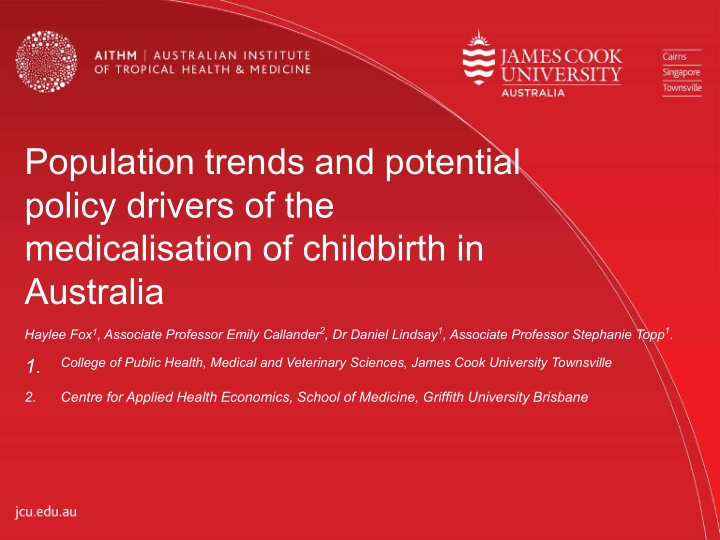



Population trends and potential policy drivers of the medicalisation of childbirth in Australia Haylee Fox 1 , Associate Professor Emily Callander 2 , Dr Daniel Lindsay 1 , Associate Professor Stephanie Topp 1 . 1. College of Public Health, Medical and Veterinary Sciences, James Cook University Townsville 2. Centre for Applied Health Economics, School of Medicine, Griffith University Brisbane
Background – Global Global CS rates have almost doubled in the last 15 years 6.2 million excess CS performed globally each year CS use more frequent in births in the richest quintiles ‘Too little too late, too much too soon’
Background - Australia 70.0% 60.0% 50.0% 40.0% 30.0% 20.0% 10.0% 0.0% 2000 2001 2002 2003 2004 2005 2006 2007 2008 2009 2010 2011 2012 2013 2014 2015 2016 2017 Caesarean section Public hospitals Private hospitals Induction of labour Episiotomies Vaginal delivery (non-instrumental)
Methods
Data linkage Maternity1000 linked dataset: hospital data; Emergency Department information System; MBS; PBS; Costing records All mothers who gave birth in Queensland between 2012 and 2015 (n=186,789), plus their resultant babies (n= 189,909) total n=376,698.
Population trends Adjusted caesarean section rates in Hospital and Health Service jurisdictions in Queensland Association between socio economic and demographic characteristics and birth delivery type with chi-square analysis Odds Ratios of likelihood of receiving obstetric intervention and having an unassisted vaginal delivery Confounding variables: pre-existing health condition, maternal age, previous pregnancy complications, complications arising during the current pregnancy, obesity, area-based socioeconomic deprivation, distance from the birthing facility, and smoking Analysis was undertaken using SAS9.4 statistical software.
Methodology – scoping review Scoping review of Australia’s macro level health and financing mechanisms Interpretative synthesis of their impact on the delivery of maternity care Google search engine; targeted websites; academic databases
Results
Figure 1: Caesarean section adjusted percentages by Hospital and Health Service jurisdiction
Sociodemographic characteristics of mothers receiving obstetric intervention during labour and birth in Queensland between 01/07/2012 and 30/06/2015 80 70 60 50 40 30 20 10 0 Caesarean section Instrumental vaginal birth Vaginal (non-instrumental) birth Induction of labour Episiotomy Epidural
Cesarean section Instrumental vaginal birth Vaginal (non- Induction of labour Episiotomy Epidural instrumental) birth OR 95%CI OR 95%CI OR 95%CI OR 95%CI OR 95%CI OR 95%CI Indigenous 0.94 0.90 – 0.99 0.70 0.65 - 0.77 1.14 1.09 - 1.19 0.86 0.82 - 0.90 0.65 - 0.80 0.74 0.69 - 0.79 Inner Regional 0.96 0.93 – 0.99 0.92 0.88 – 0.97 1.06 1.03 – 1.09 1.10 1.10 - 1.13 0.89 0.84- 0.95 0.98 0.94 – 1.02 Outer Regional 1.03 1.00 - 1.06 0.87 0.83 - 0.91 1.01 0.9-1.0.4 1.10 1.07 - 1.14 0.94 0.89 - 1.00 0.79 0.76 - 0.82 Remote 1.10 1.05 - 1.15 0.77 0.72 - 0.83 1.00 0.96 - 1.04 1.05 1.00- 1.10 0.88 0.80 – 0.95 0.57 0.54 - 0.61 Very remote 1.00 0.95 - 1.10 0.85 0.77 - 0.94 1.05 0.99 - 1.11 1.20 1.17- 1.32 0.85 0.76 – 0.96 0.60 0.55 - 0.66 IRSD 1 0.93 0.89 – 0.97 0.80 0.75 – 0.86 1.15 1.10-1.20 0.79 0.75- 0.83 0.63 0.58- 0.69 0.72 0.68 - 0.77 IRSD 2 0.95 0.92 – 0.98 0.85 0.81 - 0.89 1.11 1.08 -1.14 0.91 0.88- 0.94 0.70 0.66 - 0.74 0.90 0.86 - 0.94 IRSD 3 0.99 0.96 - 1.03 0.90 0.85 - 0.94 1.04 1.01- 1.08 0.84 0.81- 0.87 0.80 0.75- 0.85 0.96 0.92 – 1.00 IRSD 4 0.88 0.85 - 0.90 0.93 0.89 – 0.97 1.15 1.12 - 1.19 0.95 0.81 – 0.87 0.72 0.75 - 0.85 1.01 0.97 – 1.10
Scoping review 1. Privatisation of maternity care 2. Medicalisation of maternity care 3. Funding models incentivising volume of care 4. Limiting of access midwifery continuity of care models
Policy implications – what needs to change? Funding based on quality indicators that preference woman-centred outcomes as opposed to funding models that reward volume What are the links between macro-level financing and hospital- and health provider-level approaches to maternity care? Prioritise publically funded midwifery continuity of carer models
Recommend
More recommend